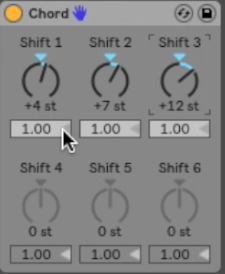Chord Triggers are a great tool. As a Keyboard player who is constantly playing the parts of several people with just ten fingers, they can be quite indespensible.
It’s always better to think in terms of artistic value though, as opposed to a necessary aid for covering more ground then physically possible.
So the question then has always been, how to I keep more chord triggers sounding, natural, clean, and transparent.
Here are three tricks I’ve come up with over the years that have helped me to use chord triggers in an effective way.
I have also built a diatonic chord trigger that works in all 12 keys for you.
You can download a free copy of that by clicking here.
It’s touch sensitive so high velocities produce bass notes, and low velocities only chords, and it uses lush piano voicings that I might play myself without a chord trigger.
Make Use Of the Velocity Controls
All notes are not created equal. Lower notes are going to have a lot more power and take up a lot more space. As a piano player, we are touching the bass notes with less pressure than higher notes, so it’s helpful to have this reflected in our chord triggers, especially on touch-sensitive instruments.
The velocity controls on the Chord device can be found right below each “Shift”

A value of 1 will output your shift as equal velocity to the triggered note. Higher values will produce higher velocities, and lower values, lower velocities.
Consider using lower values for lower notes, and higher values for higher notes
Add An Octave
As piano players, we often have doubled notes in our voicing. So have this reflected in our triggered chords is going to add a more human and natural feel.
Consider doubling one of your notes by adding 12 to whichever voice you would like to double.
For example, to double the root, you would use +12. To double the second note in the above example, we would add 12 to our first shift, which is +4. So our next shift would be +16
Group Chord Triggers Into A Midi Effect Rack
Abletons chord device is lovely, but it really only lets you program one chord at a time. If you are using the chord trigger in a live context, you will want to be able to have difference voicings, as well as a mix of different chord types, without playing with any knobs. A midi effect rack is a great way to do this

Add several chord triggers to a midi effect rack, and move the chains to cover only the notes you want to trigger the chords. Then create an empty chain to allow the other notes to pass through
This gives you the ability to:
- Use different voicing for each chord
- Create smooth voice leading where possible.
- Play a sound and have only certain notes trigger chords, allowing all the other notes to still pass through
uneffected .
What To Do Now?
First!
Experiment with some of these ideas, and try to integrate them into your workflow. You learn by doing, so get out there and create something you feel proud of.
Second
Share this post with your friends if you found it helpful, and make sure you grab a free copy of my MStoAbleton Universal Chord Trigger
Last But Not Least
Get plugged into the Mainstage To Ableton Community. Every single Tuesday and Saturday I come out with new valuable information to make using Ableton easy, and exciting.
In addition to a ton of helpful information coming your way every week, I will send you a free copy of my Ebook, “The Fast Track Patch List Guide.”
I have also been known to send out Ableton specific freebies to my community from time to time, so make sure you don’t miss out.
As always, happy creating.
Until next time,
-Brett
